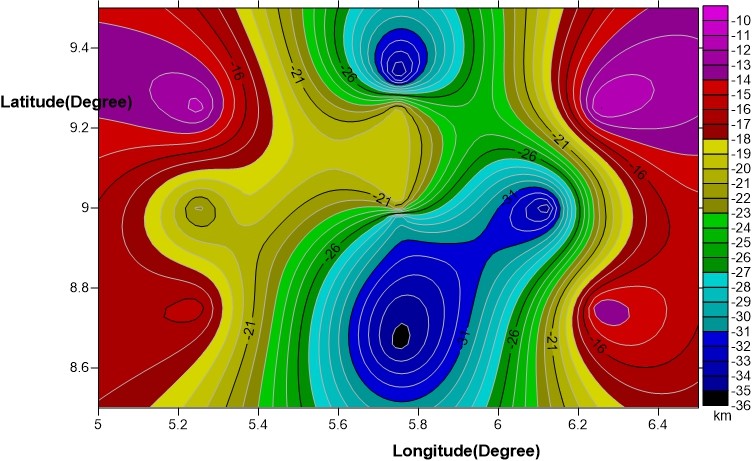Curie point Depth and Heat Flow Analyses over Part of Bida Basin, North Central Nigeria using Aeromagnetic Data
Abstract
This study attempt to estimate the Curie point depth and heat flow using high resolution aeromagnetic data over part of Bida basin bounded with longitude 5o00’E – 6o30’E and Latitude 8o30’N – 9o30’N with an estimated total area of 18,150 km2. We subjected the total magnetic intensity field of the study area to regional/residual separation using polynomial fitting. We divided the residual map into sixteen overlapping spectral blocks. We obtained centroid depths and depth to top of basement got from the plot of log of power spectrum against wave number; the centroid depth ranges from 6.61 km to 20.30 km while the depth to top of basement ranges from 1.59 km to 6.38 km. input parameter to calculate the curie depth. The CPD range from 10.88 km to 35.51 km with an average value of 23.22km. The CPD is deeper at the centre of the southern and eastern part of the study area which correspond to part of Pategi and part of Baro; and shallow at the northeastern and Northwestern part of the study area correspond to part of Mokwa and part of Bida. The geothermal gradients for the sixteen blocks range from 16.33 oCkm-1 at the centre of the southern region of the area to 53.30 oCkm-1 at the northeastern and north western region of the study area with an average of 28.98 oCkm-1. While the heat flow to range from 40.99 mWm-1 to 133.80 mWm-1 with an average value of 76.19 mWm-2. It can be deduced from this study that the Southeastern, southwestern, and the northwestern part of the study area might be a good indicator of geothermal energy potential with minimum CPD, maximum geothermal gradient and heat flow since demagnetized rocks confirm a hot rock quantity in the crust that can be harnessed for geothermal energy exploitation.
Full text article
References
Adeniyi, J. (1985). Ground total magnetic intensity in parts of the Nupe Basin and the adjacent basement complex, Niger State, Nigeria. Niger J App Sci, 3, 67-78.
Aydın, I., & Oksum, E. (2010). Exponential approach to estimate the Curie-temperature depth. Journal of Geophysics and Engineering 7(2), 113-125.
Bhattacharyya, B., & Leu, L.-K. (1977). Spectral analysis of gravity and magnetic anomalies due to rectangular prismatic bodies. Geophysics, 42(1), 41-50.
Bhattacharyya, B., & Leu, L. K. (1975). Analysis of magnetic anomalies over Yellowstone National Park: mapping of Curie point isothermal surface for geothermal reconnaissance. Journal of Geophysical Research, 80(32), 4461-4465.
Blakely, R. J. (1996). Potential theory in gravity and magnetic applications: Cambridge university press.
Jessop, A., Hobart, M., & Sclater, J. (1976). The world heat flow data collection—1975, Geothermal Series. Ottawa: Geological Survey of Canada, Earth Physics Branch, Energetic Mines Resources.
Khojamli, A., Ardejani, F. D., Moradzadeh, A., Kalate, A. N., Kahoo, A. R., & Porkhial, S. (2016). Estimation of Curie point depths and heat flow from Ardebil province, Iran, using aeromagnetic data. Arabian Journal of Geosciences, 9(5), 383.
Nwankwo, L. I., & Shehu, A. T. (2015). Evaluation of Curie-point depths, geothermal gradients and near-surface heat flow from high-resolution aeromagnetic (HRAM) data of the entire Sokoto Basin, Nigeria. Journal of Volcanology and Geothermal Research 305, 45-55. doi:https://doi.org/10.1016/j.jvolgeores.2015.09.017
Obaje, N. G. (2009). Geology and mineral resources of Nigeria (Vol. 120): Springer.
Obande, G. E., Lawal, K. M., & Ahmed, L. A. (2014). Spectral analysis of aeromagnetic data for geothermal investigation of Wikki Warm Spring, north-east Nigeria. Geothermics, 50, 85-90.
Ochieng, L. (2014). Overview of geothermal surface exploration methods. Paper presented at the Short Course IX on Exploration for Geothermal Resources, Kenya.
Ojo, S. (1984). Middle Niger Basin revisited, magnetic constraints on gravity interpretations. Paper presented at the Nigerian Mining and Geosciences Society Conference, Nsukka, Nigeria, Nsukka, Nigeria.
Okubo, Y., Graf, R., Hansen, R., Ogawa, K., & Tsu, H. (1985). Curie point depths of the island of Kyushu and surrounding areas, Japan. Geophysics, 50(3), 481-494.
Okwokwo, O. I., Adetona, A. A., Adewumi, T., & Adeniran, S. O. (2018). Interpretation of high resolution aeromagnetic data to determine sedimentary thickness over part of Bida Basin, North Central Nigeria. Journal of Geology and Mining Research 10(6), 72-80.
Ross, H. E., Blakely, R. J., & Zoback, M. D. (2006). Testing the use of aeromagnetic data for the determination of Curie depth in California. Geophysics, 71(5), L51-L59.
Spector, A., & Grant, F. (1970). Statistical models for interpreting aeromagnetic data. Geophysics, 35(2), 293-302.
Stampolidis, A., Kane, I., Tsokas, G., & Tsourlos, P. (2005). Curie point depths of Albania inferred from ground total field magnetic data. Surveys in Geophysics, 26(4), 461-480.
Tanaka, A., Okubo, Y., & Matsubayashi, O. (1999). Curie point depth based on spectrum analysis of the magnetic anomaly data in East and Southeast Asia. Tectonophysics, 306(3-4), 461-470.
Tselentis, G. (1991). An attempt to define Curie point depths in Greece from aeromagnetic and heat flow data. pure and applied geophysics 136(1), 87-101.
Udensi, E., & Osazuwa, I. (2004). Spectral determination of depths to magnetic rocks under the Nupe Basin, Nigeria. Nigerian Association of Petroleum Explorationists Bulletin, 17, 2227.
Authors
This is an open access journal which means that all content is freely available without charge to the user or his/her institution. The copyright in the text of individual articles (including research articles, opinion articles, and abstracts) is the property of their respective authors, subject to a Creative Commons CC-BY-SA licence granted to all others. JEEE allows the author(s) to hold the copyright without restrictions and allows the author to retain publishing rights without restrictions.




